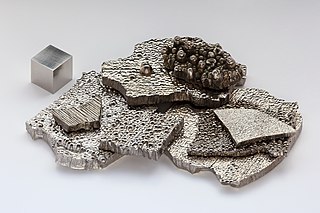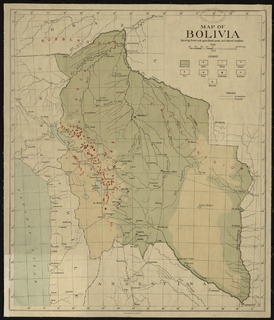
The economy of the Democratic Republic of the Congo has declined drastically around the 1980s, despite being home to vast potential in natural resources and mineral wealth; their gross domestic product is $48.994 billion as of 2019.

The economy of Rwanda has undergone rapid industrialisation due to a successful governmental policy. And has mixed economy. Since the early-2000s, Rwanda has witnessed an economic boom, which improved the living standards of many Rwandans. The Government's progressive visions have been the catalyst for the fast transforming economy. The President of Rwanda, Paul Kagame, has noted his ambition to make Rwanda the "Singapore of Africa".

Coltan is a dull black metallic ore from which the elements niobium and tantalum are extracted. The niobium-dominant mineral in coltan is columbite, and the tantalum-dominant mineral is the tantalite.

Mining in Japan is minimal because Japan does not possess many on-shore mineral resources. Many of the on-shore minerals have already been mined to the point that it has become less expensive to import minerals. There are small deposits of coal, oil, iron and minerals in the Japanese archipelago. Japan is scarce in critical natural resources and has been heavily dependent on imported energy and raw materials. There are major deep sea mineral resources in the seabed of Japan. This is not mined yet due to technological obstacles for deep sea mining.
The mining industry in India is a major economic activity which contributes significantly to the economy of India. The GDP contribution of the mining industry varies from 2.2% to 2.5% only but going by the GDP of the total industrial sector it contributes around 10% to 11%. Even mining done on small scale contributes 6% to the entire cost of mineral production. Indian mining industry provides job opportunities to around 700,000 individuals.

Mining in Australia has long been a significant primary sector industry and contributor to the Australian economy by providing export income, royalty payments and employment. Historically, mining booms have also encouraged population growth via immigration to Australia, particularly the gold rushes of the 1850s. Many different ores, gems and minerals have been mined in the past and a wide variety are still mined throughout the country.

Mining in Iran is still under development, yet the country is one of the most important mineral producers in the world, ranked among 15 major mineral-rich countries, holding some 68 types of minerals, 37 billion tonnes of proven reserves and more than 57 billion tonnes of potential reserves worth $770 billion in 2014. Mineral production contributes only 0.6 per cent to the country's GDP. Add other mining-related industries and this figure increases to just four per cent (2005). Many factors have contributed to this, namely lack of suitable infrastructure, legal barriers, exploration difficulties, and government control.

The mining industry of the Democratic Republic of the Congo plays a significant role in the world's supply of cobalt, copper, diamonds, tantalum, tin, gold and produces over 70% of the global cobalt production. It is the Democratic Republic of the Congo's largest source of export income.
Mining in Brazil is centered on the extraction of iron, copper, gold, aluminum, manganese, tin, niobium, and nickel. About gemstones, Brazil is the world's largest producer of amethyst, topaz, agate and is a big producer of tourmaline, emerald, aquamarine, garnet and opal.

Conflict resources are natural resources extracted in a conflict zone and sold to perpetuate the fighting. There is both statistical and anecdotal evidence that the presence of precious commodities can prolong conflicts. The most prominent contemporary example has been the eastern provinces of the Democratic Republic of the Congo (DRC), where various armies, rebel groups, and outside actors have profited from mining while contributing to violence and exploitation during wars in the region. An unfortunate irony is that many countries rich in minerals are impoverished in terms of their capacity for governance. Conflict, corruption and bribery may be seen as the typical costs of doing business.

Mining in South Africa was once the main driving force behind the history and development of Africa's most advanced and richest economy. Large-scale and profitable mining started with the discovery of a diamond on the banks of the Orange River in 1867 by Erasmus Jacobs and the subsequent discovery and exploitation of the Kimberley pipes a few years later. Gold rushes to Pilgrim's Rest and Barberton were precursors to the biggest discovery of all, the Main Reef/Main Reef Leader on Gerhardus Oosthuizen's farm Langlaagte, Portion C, in 1886, the Witwatersrand Gold Rush and the subsequent rapid development of the gold field there, the biggest of them all.
Burundi is a producer of columbium (niobium) and tantalum ore, tin ore, and tungsten ore, and some deposits of gold which are designated for export. Burundi has resources of copper, cobalt, nickel, feldspar, phosphate rock, quartzite, and rare reserves of uranium, and vanadium. The country is also a producer of limestone, peat, sand and gravel for domestic consumption and as building materials. As of 2005, manufacturing accounted for 8% of the country's gross domestic product.
The mineral industry of Russia is one of the world's leading mineral industries and accounts for a large percentage of the Commonwealth of Independent States' production of a range of mineral products, including metals, industrial minerals, and mineral fuels. In 2005, Russia ranked among the leading world producers or was a significant producer of a vast range of mineral commodities, including aluminum, arsenic, cement, copper, magnesium compounds and metals, nitrogen, palladium, silicon, nickel and vanadium.
The mineral industry of Mozambique plays a significant role in the world's production of aluminium, beryllium, and tantalum. In 2006, Mozambique's share of the world's tantalum mine output amounted to 6%; beryllium, 5%; and aluminium, 2%. Other domestically significant mineral processing operations included cement and natural gas.

Mining in the United Kingdom produces a wide variety of fossil fuels, metals, and industrial minerals due to its complex geology. In 2013, there were over 2,000 active mines, quarries, and offshore drilling sites on the continental land mass of the United Kingdom producing £34bn of minerals and employing 36,000 people.

Mining in Bolivia has been a dominant feature of the Bolivian economy as well as Bolivian politics since 1557. Colonial era silver mining in Bolivia, particularly in Potosí, played a critical role in the Spanish Empire and the global economy. Tin mining supplanted silver by the twentieth century and the central element of Bolivian mining, and wealthy tin barons played an important role in national politics until they were marginalized by the industry's nationalization into the Bolivian Mining Corporation that followed the 1952 revolution. Bolivian miners played a critical part to the country's organized labor movement from the 1940s to the 1980s.
Tin mining began early in the Bronze Age, as bronze is a copper-tin alloy. Tin is a relatively rare element in the Earth's crust, with approximately 2 ppm, compared to iron with 50,000 ppm.

Coltan is the colloquial name for the mineral columbite-tantalum ("col-tan"); it is sometimes incorrectly used as shorthand for tantalite, a metallic ore from which the very similar elements niobium, also known as columbium, and tantalum are extracted. In the early 21st century coltan mining was associated with human rights violations such as child labour, systematic exploitation of the population by governments or militant groups, exposure to toxic chemicals and other hazards as a result of lax environmental protection, and general safety laws and regulations.
The geology of Rwanda comprises Mesoproterozoic metasediments, largely quartzites, sandstones, and shales of the Burundian Supergroup which are locally intruded by granite. There are four types of granite in the Kibaran Belt. In eastern Rwanda are the “older granites” along with granitic-gneisses and migmatites of Palaeoproterozoic age. In the northwest and southwest are Neogene volcanics, ranging in age from Cenozoic to recent. Some of the volcanoes in the area are highly alkaline. Alluvium and lake sediments of Quaternary age occur in parts of the Western Rift and along rivers and lakes.
The Karuruma tin smelter is a tin smelting plant in the Rwandan capital, Kigali, currently operated by the company LuNa Smelter Ltd. The plant was previously operated by Phoenix Metal Ltd.












